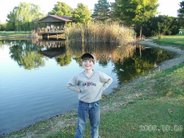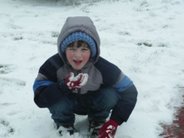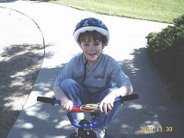The following is from the Diagnostic and Statistical Manual of Mental Disorders, Fourth Edition (DSM IV):
DIAGNOSTIC CRITERIA FOR 299.00 AUTISTIC DISORDER
A) A total of six (or more) items from (1), (2), and (3), with at
least two from (1), and one each from (2) and (3)
(1) qualitative impairment in social interaction, as manifested by
at least two of the following:
a) marked impairments in the use of multiple nonverbal behaviors
such as eye-to-eye gaze, facial expression, body posture, and
gestures to regulate social interaction
b) failure to develop peer relationships appropriate to
developmental level
c) a lack of spontaneous seeking to share enjoyment, interests, or
achievements with other people, (e.g., by a lack of showing,
bringing, or pointing out objects of interest to other people)
d) lack of social or emotional reciprocity ( note: in the
description, it gives the following as examples: not actively
participating in simple social play or games, preferring solitary
activities, or involving others in activities only as tools or
"mechanical" aids )
(2) qualitative impairments in communication as manifested by at
least one of the following:
a) delay in, or total lack of, the development of spoken language
(not accompanied by an attempt to compensate through alternative
modes of communication such as gesture or mime)
b) in individuals with adequate speech, marked impairment in the
ability to initiate or sustain a conversation with others
c) stereotyped and repetitive use of language or idiosyncratic
language
d) lack of varied, spontaneous make-believe play or social
imitative play appropriate to developmental level
(3) restricted repetitive and stereotyped patterns of behavior,
interests and activities, as manifested by at least two of the
following:
a) encompassing preoccupation with one or more stereotyped and
restricted patterns of interest that is abnormal either in
intensity or focus
b) apparently inflexible adherence to specific, nonfunctional
routines or rituals
c) stereotyped and repetitive motor mannerisms (e.g hand or finger
flapping or twisting, or complex whole-body movements)
d) persistent preoccupation with parts of objects
B. Delays or abnormal functioning in at least one of the following
areas, with onset prior to age 3 years:
(1) social interaction
(2) language as used in social communication
(3) symbolic or imaginative play
C. The disturbance is not better accounted for by Rett's Disorder
or Childhood Disintegrative Disorder
The following definition is from the Autism Society of America:
AUTISM is a severely incapacitating lifelong developmental disability that typically appears during the first three years of life. It occurs in approximately 1 out of every 160 births and is four times more common in boys than girls. It has been found throughout the world in families of all racial, ethnic and social backgrounds. No known factors in the psychological environment of a child have been shown to cause autism.
The symptoms are caused by physical disorders of the brain. They include:
Disturbances in the rate of appearance of physical, social and language skills.
Abnormal responses to sensations. Any one or a combination of senses or responses are affected: sight, hearing, touch, pain, balance, smell, taste, and the way a child holds his body.
Speech and language are absent or delayed while specific thinking capabilities might be present.
Abnormal ways of relating to people, objects and events.
Autism occurs by itself or in association with other disorders which affect the function of the brain such as viral infections, metabolic disturbances, and epilepsy. It is important to distinguish autism from retardation or mental disorders since diagnostic confusion may result in referral to inappropriate and ineffective treatment techniques. The severe form of the syndrome may include extreme self-injurious, repetitive, highly unusual and aggressive behavior. Special educational programs using behavioral methods have proven to be the most helpful treatment.
AUTISM IS TREATABLE -- Early diagnosis and intervention are vital to the future development of the child.
Note: an example of a dictionary-definition of autism is: "absorption in fantasy as escape from reality". Obviously there is a big difference between the traditional definition documented by dictionaries and the syndrome this memo addresses. The difference stems from changes in word usage: in the 30s and 40s, psychologists first observed a number of children with the above symptoms and called it "early infantile autism", borrowing the word "autism" which had already been applied by psychologists to describe people who try to escape from reality. Today, most discussion of autism (at least in the USA) centers on children diagnosed as having "early infantile autism" and everyone refers to it simply as "autism". But occasionally there is confusion when someone who means "early infantile autism" talks to someone who is thinking of the original definition. In this document, we will use the term "autism" in the sense of "early infantile autism" and refer explicitly to "early infantile autism" only when discussing both senses of the word.
The definition of the syndrome listed above is oriented to children, but note that such children do not outgrow their autism. Much of the literature on autism deals with children because educating them is such a big issue that more research, education, and writing on autism is about children than adults.
Subscribe to:
Post Comments (Atom)


























 This website is part of the autism-assembly, this is a coalition of
members of the autistic community who share the common goal of seeking
acceptance for those on the autistic spectrum, who aim to educate about
autism, and who are not seeking a cure for autism. This is part of the
global autism rights movement.
This website is part of the autism-assembly, this is a coalition of
members of the autistic community who share the common goal of seeking
acceptance for those on the autistic spectrum, who aim to educate about
autism, and who are not seeking a cure for autism. This is part of the
global autism rights movement.



No comments:
Post a Comment